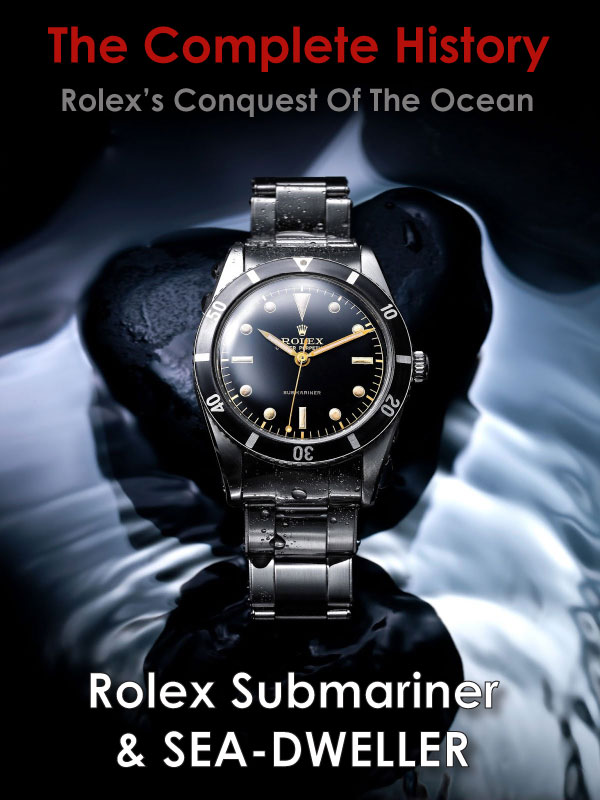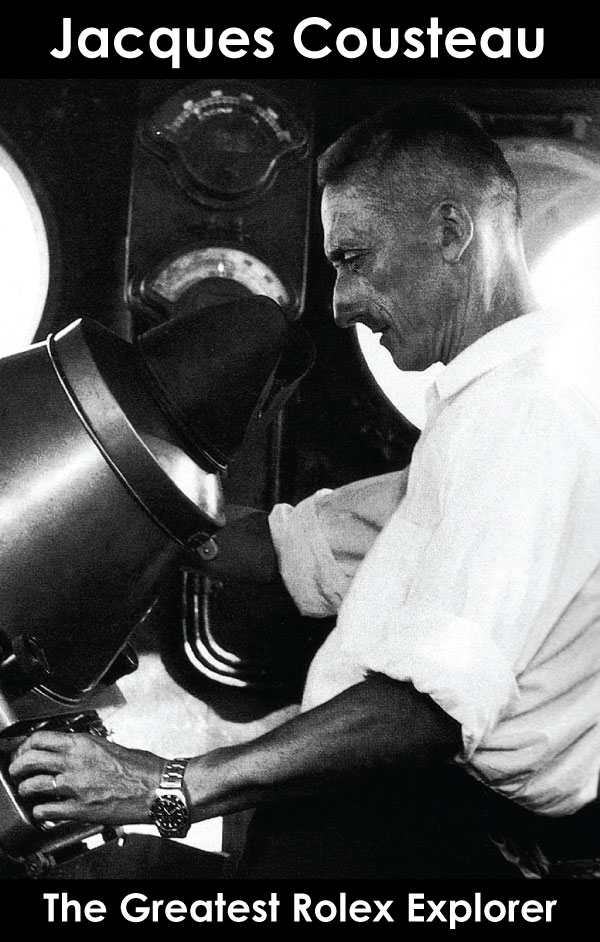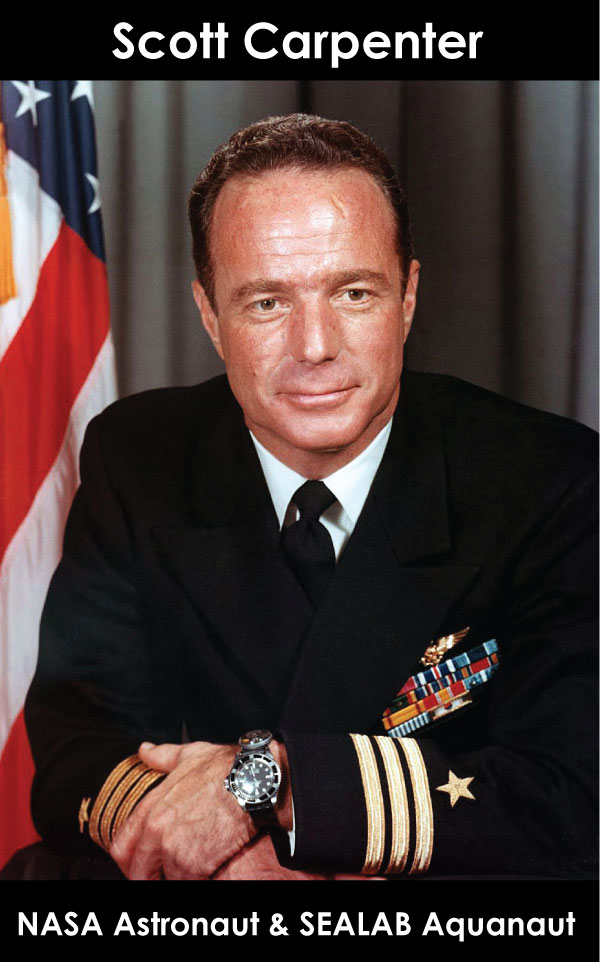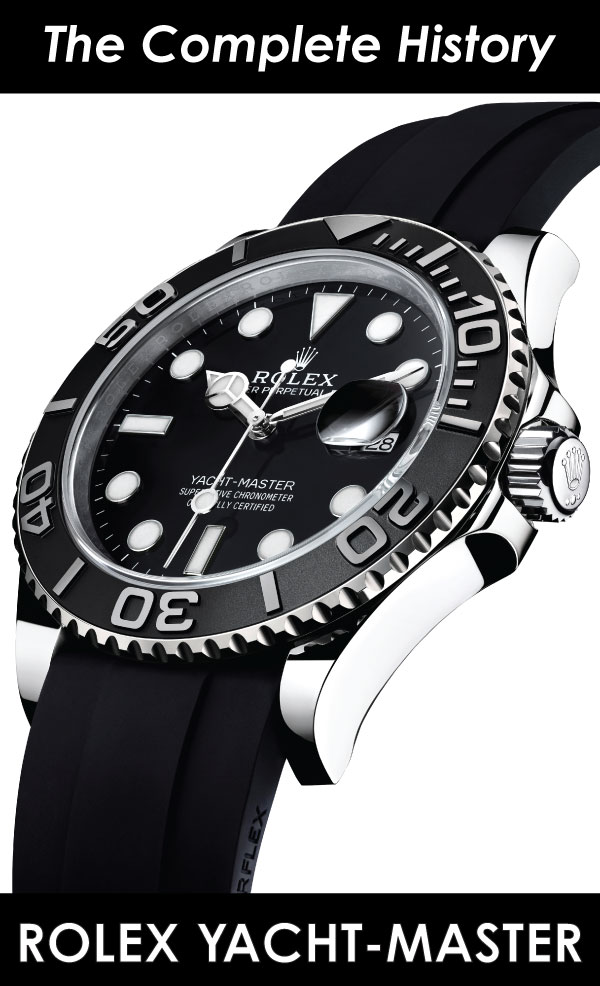A Great Rolex Explorer Passed Away
Jacques Piccard (pictured below) was born in 1922 and passed away at his home on Lake Geneva last week on November 1, 2008 at the age of 86. He and his father, Professor Auguste Antione Piccard, and his son Bertrand Piccard are considered to be three of the greatest explorers that ever lived.
The Swiss family Piccard's have pushed the envelope of exploration like no others–for 3 straight generations. Jacques Piccard's father, Auguste Piccard was the first man to ascend in a balloon into the earths stratosphere in 1931 and Jacques son Bertrand Piccard was the first man to fly non-stop around earth in a balloon named Orbiter 3 in March of 1999.

Jacques Piccard
Jacques Piccard was a highly accomplished Swiss hydronat, oceanographer and a pioneer of deep-sea exploration.
The Piccard family also had a close association with Rolex on many levels. The Piccard's completed much of the testing for the Rolex DEEP SEA SPECIAL which began in 1950 and culminated in 1960 when Jacques Piccard descended down to deepest chasm of the ocean floor known as the Marianas Trench (located a few hundred miles off the coast of Guam) with a Rolex DEEP SEA SPECIAL attached to the outside of the Bathyscaphe.
Pictured above one of 6 known examples of the Rolex DEEP SEA SPECIAL
On January 23, 1960, the Bathyscaphe, Trieste dove 7 miles (35,800 feet or 11 Kilometers) below sea level down to the ocean floor with a Rolex DEEP SEA SPECIAL attached to its exterior, and when it came up the Rolex DEEP SEA SPECIAL was perfectly intact and fully functional. This set a depth level that has never been surpassed because there is no place on earth mankind knows of that is deeper.
The relationship between Rolex and the Piccard's continued through the 1960s with the launch of the Mesoscaphe in 1964.
In Jacques Piccard's autobiographical account of his record-breaking dive to the Marianas trench, he recounted seeing a great expanse of sea-life including shrimp and flatfish. He was shocked to see underwater life thriving in such adverse and extreme conditions. His discovery led subsequently to the banning of nuclear waste being dumped into the ocean.
To best understand Jacques Piccard's historical significance and his relationship with Rolex we must go back to the beginning of the story and begin with his scientist/explorer father–Professor Auguste Piccard.
Professor Auguste Piccard
Gene Roddenberry, the creator of Start Trek was so inspired by Auguste Piccard's lifetime achievements, he named the captain of Star Trek–The Next Generation after him–Jean-Luc Picard.
Auguste Piccard was a Swiss explorer, physicist, and inventor born in Basel, Switzerland on January 28, 1884. Auguste Piccard died on March 24, 1962. From a very young age August was extremely passionate and curious about science.
Auguste Piccard at the 1927 Solvay Conference
Auguste attended The Swiss Federal Institute of Technology in Zurich, Switzerland and went on to become a physics professor in Brussels at the University of Brussels. In 1930, Auguste developed a fascination with ballooning and a tremendous curiosity about earths upper atmosphere know as the stratosphere.
Auguste Piccard was considered to be one of the most brilliant minds in the scientific community and collaborated with Albert Einstein and Marie Curie. The photo below was taken in October, 1927 at the Fifth Solvay International Conference of Electrons and Photons, where the world's most notable physicists met to discuss Einstein's newly formulated Quantum Theory.
Jacques Piccard is pictured standing in the upper left hand corner and Marie Curie is the female sitting second from the left in the front row with Einstein sitting on the far right.
Auguste Piccard was also one of the foremost authorities on cosmic rays and proved part of Einstein's Theory of Relativity to be true in an experiment he conducted in his balloon. He also discovered an element knows as Uranium 235 which he named Actinuran.
In the years to follow, Auguste Piccard would go on to receive the honor of becoming a Commander of the Legion of Honour in France as well as the Order of Leopold.
In 1930 Auguste Piccard designed and built a spherical, pressurized gondola that was attached to a balloon–which is pictured below. The pressurized gondola allowed him to ascend higher in altitude without having to wear a pressurized suit. Auguste Piccard's pressurized cabin was a huge innovation that made possible modern passenger aviation as well as space exploration.
"Exploration is the sport of the scientist."
–Auguste Piccard, May 27, 1931
Conquering The Stratosphere
Auguste Piccard took off with Paul Kipfer from Augsburg, Germany on May 27, 1931 and broke the altitude record by ascending 51,961 feet (15,838 meters) up into the heavens thus becoming the first manned flight into the stratosphere. On this fantastic voyage, Piccard was able to learn a great deal about cosmic rays and the upper atmosphere.
Auguste endeavored into the stratosphere because he believed it would be necessary to get above the earth's atmosphere to learn more about cosmic rays that come from distant stars.
Auguste Piccard conducted a total of 27 ballon flights and set a final record of 72,177 feet (23,000 meters).
Auguste contracted with a German company to build his 500,000 cubic foot balloon that was made from rubberized cotton. Auguste also designed the spherical gondola that could carry two people more than 50,000 feet up into the stratosphere without the need for pressurized suits. The Gondola was equipped with a system developed in Germany during World War I which allowed the two occupants in the gondola to breath recycled air.
Auguste Piccard drawn by Robert Kastor in 1932 (Library of Congress)
One day in 1936, Auguste had a huge epiphany when he realized that by modifying his pressurized sphere he could create an underwater Zeppelin that could descend deeply into the ocean and be navigated through the sea just like a Zeppelin navigates through the air with two electrically driven propellers. World war II slowed his progress, but after the war he resumed his progress and made a new ship that could descend deeply underwater.
Jacques Piccard is pictured above reviewing design details with his father, Professor Auguste Piccard. In the photo below Jacques is moving the microphone in front of his father Auguste at a conference. Jacques and his father, Auguste were extremely close and collaborated on the design and development of many technological innovations.
In 1946, Auguste, with the help of his son Jaqcues began building his first bathyscaphe and completed construction in 1948. This new vehicle was designed for DEE-SEA descents and it worked just like his spherical balloon but in reverse. The gondola for his ballon was designed to keep pressure in, while his new underwater gondola was designed to keep pressure out.
Think of the bathyscaphe as an underwater balloon which depends upon gasoline to lift it. Gasoline is lighter than water and hydrogen and helium are lighter than air. August wrote in his book titled Earth, Sky & Sea that "It was the submarine that led me to the stratosphere.
In his first experiments with his Bathyscaphe named FNRS-2 (FNRS-1 was his stratospheric balloon) he experimented with unmanned dives and in 1948 he gave it to the French Navy. In 1954 the FNRS took a man safely down 13,700 feet (4,176 Meters).
The Bathyscaphe F.N.R.S. 2
Just like his ballon with the pressurized sphere that fit two people, the first bathyscaphe also fit two people.
After the tremendous success of the FNRS-2, August and Jacques built a much improved craft they named the Bathyscaphe Trieste which is pictured below the map. They named it the Trieste because many of the people and institutions that helped fund the venture were from Trieste, Italy.
The Bathyscaphe Trieste
The Bathyscaphe Trieste was more like a underwater blimp or zeppelin than a submarine. Just like Auguste Piccard's first stratospheric ballon and first bathyscaphe, which had a two passenger sphere located a the bottom, so did the bathyscaphe Trieste.
As indicated in the illustration below, the bathyscaphe Trieste was not like a submarine. It was like a huge underwater balloon or Zeppelin.
Auguste and Jacques Piccard made many dives off the coast of Italy beginning in 1953 with the Bathyscaphe, Treiste. The photo below is a close up of the sphere at the bottom where two people could barely fit.
In 1953 Auguste and his son Jacques set a record by diving down 3150 meters together in the Trieste. This made Auguste the man who had flown the highest and dived the deepest–an extreme record that is mind-boggling.
The Two Jacques
Jacques Cousteau, the french explorer and diver was credited with popularizing the aqualung which allowed people to scuba dive underwater without hoses attached to a ship above. Today we take scuba diving for granted but back in the 1940's when Jacques Cousteau began popularizing this technology it was considered to be a tremendous innovation.
Jacques Cousteau pictured above in the 1940s wearing an early Aqualung that would make skin diving possible as a recreational sport. Jacquest Cousteau would continue diving into his eighties.
Jacques Cousteau talking with Scott Carpenter
Jacques Cousteau is pictured above with Scott Carpenter who was one of the Original 7 Mercury astronauts. Scott went on to become a U.S. Navy SEALAB aquanaut where his diving research contributed to the development of the Rolex SEA-DWELLER and the helium gas release valve in particular.
Rolex under the direction of Rene Paul Jeanneret had been working on developing a specialized watch just for scuba divers also known as skin divers. Rolex had come up with many ideas for the name of this new watch. They called it the Sub Aqua, then they changed it to the Monograph, then they called it the Turn-O-Graph, and finally settled on the name Submariner.
The image above is from John Goldberger's magnificent book named "100 Superlative Rolex Watches." This pre-Submariner is named "Monometer." If you click on the image above you will see the Monometer designation under the word Rolex on the dial.
Rolex apparently had the Submariner developed and ready for market in 1950. Rolex decided they wanted to make a huge marketing splash (pun not intended) so they developed a special watch named the DEEP SEA SPECIAL and they developed a strategic partnership with Auguste and Jacques Piccard to have them submerge down to a record depth with a DEEP SEA SPECIAL attached to the side of the F.N.R.S. 2.
The Rolex DEEP SEA SPECIAL
When the F.N.R.S. 2 ascended from a record breaking dive in 1950, they checked the watch and it had failed. Rolex was very disappointed so they refocused their effort and significantly modified the DEEP SEA SPECIAL. This apparently held back the introduction of the Submariner for several years.
On September 30, 1953 Jacques Piccard piloted the Bathyscape Trieste down to a record depth of 10,335 feet below the ocean surface with another Rolex DEEP SEA SPECIAL attached to the outside. When the Bathyscape ascended, they checked the Rolex DEEP SEA SPECIAL that was attached to the outside of the Bathyscape and it was intact and kept perfect time.
Below is a Rolex advertisement from 1954 that introduced the Rolex Submariner by telling the story of the DEEP SEA SPECIAL that was attached to the outside of the Trieste.
From the top of the world to the bottom of the sea. Rolex proves dependable!
In the same year when the roof of the world was at last conquered by the Rolex equipped Everest expedition, the Rolex Company produced a special "Oyster" model watch which, affixed to the "Bathyscaphe Trieste," submerged to 10,330 feet...and after surfacing was in perfect condition...keeping perfect time.
With the new-found sport..."skin-diving"...and as a result of deep-sea testing, Rolex is now able to add to the equipment of skin-divers with a unique, new water-proof, pressure-proof watch...the "Submariner." This instrument has a special rotating bezel, enabling the user to determine elapsed time at a glance, for instance, it keeps a diver alert to how much time he has before his supply of air will run out. The "Submariner" has almost all the advantages of a stop watch with none of the complications. Unconditionally guaranteed against any water pressure...here is anther truly incomparable Rolex masterpiece.
Be sure to write for the special free booklet on the Rolex "Submariner."
ROLEX
A Legend in the History of Time Movement
Mention the National Geographic–It identifies you
As a side note, the text of the above Rolex advertisement mentions "In the same year when the roof of the top of the world was at last conquered by the Rolex equipped expedition..." they were referring to Sir Edmund Hillary's expedition that conquered Mount Everest.
It is a fascinating coincidence that Sir Edmund Hillary also passed away this year. The men who in 1953: took a Rolex up to the highest point on earth (Hillary) and took a Rolex down to the lowest point of earth (Jacques Piccard) both died in the same year–55 years after their crowning achievments–what a coincidence!!!
At Basel fair in the spring of 1954, Rolex launched the Rolex Submariner which went on to become the most iconic and successfully selling Swiss sport watch in history.
The first Rolex Submariner from 1954 would have looked like the watch above. Notice it has 3,6,9 indices where the current model has rectangular indices and rectangular indices as apposed to the current round indices. Also, the bezel of the original Submariner, as pictured above, lacks minute indices from 1-15 on the bezel like the current Submariner has.
In many ways, the original Submariner looked like a Rolex Explorer with the 3,6,9 indices. I believe from a design perspective, Rolex eventually eliminated the 3,6,9 indices on the Submariner dial because the numbers elementally competed too much with the minute numbers on the bezel.
The Rolex DEEP SEA SPECIAL
The DEEP SEA SPECIAL was an interesting watch and Rolex only made six of them. It was never really meant to be a production model, but some Rolex executives wore them just for fun. The crystal was highly domed to resist pressure. If you have ever taken a chicken egg and pressed it as hard as you can on the top and the bottom at the same time you will not be able to break it because the curvature creates an extremely strong dome.
The photos below of the DEEP SEA SPECIAL were taken by Percy who is the co-owner of the German Rolex forum located at R-L-X.de.
Putting Things In Perspective
James Dowling is one of the leading Rolex history experts on planet earth. In the photo below he is wearing one of the original DEEP SEA SPECIAL Rolex watches on his wrist. This watch was able to go down to the Marianas Trench and sustain a depth of 10,330 feet in 1953 and in 1960 went down successfully 7 miles (35,800 feet or 11 Kilometers).
About two months ago Rolex released for sale, an all new SEA-DWELLER named the DEEP-SEA which can safely go to 12,800 feet or 3800 meters (pictured below). The obvious question is where would or could you ever take the new DEEP SEA where it would be subjected to such depths? You can't, because the human body can not handle that kind of pressure.
This next photo was also taken by James Dowling of a prototype DEEP-SEA SEA-DWELLER at Basel fair in 2008.


The all-new Rolex DEEP-SEA SEA-DWELLER is pictured below. While being arguably over-engineered, it definitely pays homage to its great grandfather, the DEEP SEA SPECIAL.
In 1957 the Piccard's sold the Bathyscaphe, Trieste to the U.S. Navy for a quarter of a million dollars. In 1960 Jacques Piccard with his U.S. Navy counterpart, Captain Don Walsh descended down to 35,800 feet (7 miles) a few hundred miles off the coast of Guam in the Marianas Trench in the Bathyscaphe, Trieste.
Under the Sea, In An Octopus' Garden In The Shade
In Jacques Piccard's autobiographical account of his record-breaking dive to the Marianas trench, he mentioned being shocked to see a great expanse of sea-life including octopus, shrimp and flatfish.
He was blown-away to see underwater life thriving in such adverse and extreme conditions. He said "We were astounded to find higher marine life forms down there at all!?! His profound discovery led subsequently to the banning of nuclear waste being dumped into ocean trenches.
Jacques Piccard is pictured below after he came back up from the record breaking dive
It was stormy just before the big dive with six foot swells, but as the Trieste began diving it became very peaceful. We would be warm below the storm, in our little hideaway beneath the waves. Resting our head on the sea bed, in an octopus' garden near a cave.
Jacques Piccard is pictured below with his U.S. Navy counterpart Captain Don Walsh while on their extreme record breaking dive to the Marianas Trench.
The cover of life magazine below shows Jacques and Walsh after they surfaced from their record breaking dive. Their record stands today and has never been broken.
The Photo below is of the Bathyscaphe Trieste after it surfaced from its record breaking 7 Mile Dive. Somewhere, attached to the Bathyscaphe in this photo is a Rolex DEEP SEA SPECIAL that would soon be examined and found to be in perfect working order.
And Our Friends Are All Aboard–Le Mesoscaphe
The French Rolex magazine advertisement below is from 1964 and it says: "Rolex, the inventor of the wristwatch is proud to associate with the Piccard family becoming the official chronometer of the Mesoscaphe after being the official chronometer of the Bathyscaphe. The Mescoscaphe will be the submarine of Peace and will be the flagship of Swiss industry know how."
The Mesocaphe was the first passenger submarine and during the Swiss National Exhibition of 1964, Jacques Piccard transported more than 33,000 tourists–40 at a time.
I found a fascinating online French video documentary about the Piccard Mesocaphe which is in French. I don't speak French but it is fascinating just to watch and see Jacques Piccard speak and see the Mesocaphe diving. You can view the video by clicking here.

NASA Comes Calling
Wernher von Braun from NASA had been closely following Jacques Piccard's amazing career and achievements. Von Braun collaborated with Jacques Piccard to design and build a state of the art deep sea submarine named the Ben Franklin to examine the behavior of aquanauts in a self-contained, sealed, self sufficient capsule that would simulate how life may be for astronauts during long distance space travel.
The resulting research provides invaluable insight and data for future NASA habitats aboard Skylab, on the Space Shuttle and aboard the International Space Station.
Jacques Piccard above with Wernher von Braun of NASA
Jacques Piccard above with Dr. Kurt Debus at NASA
The Ben Franklin PX-15 by Jacques Piccard
In 1969, Jacques Piccard with his NASA team of 5 other submariners navigated the Gulf Stream from Florida to Nova Scotia in a Mesoscaphe named The Ben Franklin, which Jacques Piccard designed. On that trip the Ben Franklin drifted more than 1400 miles without power which was intentional to see how far they could travel just following the gulf stream currents. They ended up gliding for a month.
Cutaway drawing of the Ben Franklin Submarine from Popular Science
"Sailors, a brave and valuable order of men"–Benjamin Franklin
The NASA submariner that Jacques Piccard designed was named the Ben Franklin because in 1785 Benjamin Franklin is regarded as being the man who discovered the Atlantic ocean gulf stream and was the first person to clearly define how and why it worked as seen in the following illustration named Benjamin Franklin's Map of the Gulf Stream:
NASA's Conquest of Inner and Outer Space
Parallel worlds–this is the story of three NASA astronauts & six NASA aquanauts–and this is where the story really starts to get interesting.
In the middle of July, 1969 two remarkable and historic NASA missions got underway. On July 15, 1969 the NASA's PX-15 Ben Franklin submarine set its course on its 30 day mission to glide through the gulf stream.
A day later on July 16, 1969 Apollo 11 took off for man's first mission to walk on the moon, thus completely shadowing NASA's Ben Franklin submarine project. Within 24 hours, one space ship that was 50 feet long left the earth's atmosphere to explore inner space with six brave men onboard, while another space ship attached to a 370 foot tall Saturn rocket which generated 7.6 million pounds of thrust sent 3 men out of earth's atmosphere to explore outer space and the Moon. The parallels are profoundly uncanny!!!
It was a coincidence that Apollo 11 took-off for the Moon at the same time as the PX-15 took off for the Gulf Stream drift dive. The PX-15 Ben Franklin was plagued with last minute challenges that delayed it from its original launch date of a month earlier.
In another amazing coincidence, the company that made the Lunar Module for Apollo, named Grumman Corporation, also made the Ben Franklin PX-15 Submarine. The Ben Franklin was built in the Swiss Alps, disassembled and shipped to Florida where it was re-assembled.
Two NASA teams took-off in mid July, 1969 to explore outer and inner space; one traveled at speeds in excess of 25,000 miles per hour while the other NEVER traveled faster than 6 miles per hour. Both traveled in darkness, one to the Sea of Tranquility, the other to the Sea–off Nova Scotia.
Comic strips can be a great way of communicating a complicated story and the Frontiers Of Science comic strip pictured below did a great job.


We All Live In A Yellow Submarine
The Ben Franklin had a 6 member team with Jacques Piccard being the mission leader. Erwin Aebersold who was also Swiss was chosen to be the pilot, and he also oversaw the design and assembly of the Franklin. Chet May was a NASA scientist who specialized in studying men working in space environments.
The official NASA Mission patch is pictured above
Don Kazimir was the Captain, Frank Busby was chosen to conduct a survey over the drift track of the Continental Shelf. Ken Haigh from the British Royal Navy was the acoustic specialist in charge of conducting sonic experiments.
The Ben Franklin submarine is pictured above in dry dock. It had four outboard propellers and many observation windows.
The above photo is a rear view of the Ben Franklin with its propellers pointed up in the lift position. Jacques Piccard designed this masterpiece of the deep.
The photo above is a side view of the Ben Franklin in dry-dock.
In the photos above and below the Ben Franklin is in the water and being prepped for its long maiden voyage.
I can't help but wonder if thy they decided to paint the Ben Franklin yellow because of the extremely popular Beatles movie and theme-song "Yellow Submarine."
In the photo below the Ben Franklin is leaving for her maiden voyage
In this next shot below, the Ben Franklin is being towed to the high-velocity center of the Gulf Stream off the coast of Palm Beach, Florida.
In yet another twist of fate, the Ben Franklin launched from Florida right next to where Apollo 11 launched. On her maiden voyage, the Ben Franklin left Florida, and dove straight into the gulf stream, where she immediately turned off her engines and coasted for 30 days straight all the way up to the sea off Nova Scotia bypassing Charleston, North Caroline and Cape Hatteras before heading out into the much deeper waters of the Atlantic.
So we sailed up to the sun, till we found the sea of green, and we lived beneath the waves–in our yellow submarine.
The map above details the course the Ben Franklin took from West Palm Beach Florida to Nova Scotia. The map above is color coordinated to show the temperature of the water.
The map below illustrates the depth of the water of the journey
In the photo below we see Jacques Piccard at the helm of the ship he designed.
In the photo below we see Jacques Piccard examining an engineering report. Notice in the photo above he seems to be wearing a stainless steel Rolex Submariner and in the photo below he is wearing his yellow gold Rolex Datejust on a Jubilee bracelet.
In the photo below Swiss born Erwin Aebersold and Jacques Piccard are celebrating a Swiss holiday known as Nationalfeiertag which celebrates Switzerland's birthday or independence day which was originally declared on August 1, 1291.
In the town where I was born, lived a man who sailed the sea, and he told us of his life in the land of submarines.
In the photo below the team is enjoying a meal together. One of the mission objectives was to explore how men would get along living in a confined space for a long period of time. The data collected from this mission was incorporated by NASA in to later missions aboard Skylab, The Space Shuttle and the International Space Station.
According to NASA "During the course of the dive, NASA conducted exhaustive analyses of virtually every aspect of onboard life. They measured sleep quality and patterns, sense of humor and behavioral shifts, physical reflexes, and the effects of a long-term routine on the crew. The submarine's record-shattering dive influenced the design of Apollo and Skylab missions and continued to guide NASA scientists as the devised future manned space-flight missions."
Things were not always easy aboard the Ben Franklin. When they took off one of the men had a cold, and passed it along to all six members. Also, the temperature onboard was a constant 57 degrees, which was chilly.
In the photo above we see Jacques Piccard playing chess on a teeny-tiny portable magnetic travel chess set. The submariners had a lot of time to pass onboard. In the photo below, we see the ships medical officer examining another crew member since they all caught colds.
Notice in the photo above and below that the crew member on the right is wearing a Rolex Submariner.
As we live a life of ease, everyone of us is all we need. Sky of blue and sea of green in our yellow submarine.
The photo below was taken when the Ben Franklin entered New York Harbor after successfully negotiating its NASA mission.
In the photo above you see the New York City skyline in the background. That is the Empire State building on the far right and you also see the Chrysler building top peeking out from behind the Seagram's building which was designed by the famous German Bauhaus architect, Mies van der Rohe.
In the photo above and below you see the crew on-top of the Ben Franklin as they prepare to meet their families. Notice their outfits with the white pants and the yellow windbreakers are color coordinated to match the Ben Franklin's yellow and white paint job.
Jacques Piccard is pictured bellow with his wife and three children as they welcome him back from his fantastic journey. Jacques Piccard believed that the Ben Franklin NASA mission was of extreme importance to humanity.
The timing of the NASA Ben Franklin mission was the worst possible because it was completely dwarfed by the simultaneously occurring NASA Apollo 11 Moon Mission. If the Ben Franklin NASA mission had taken place any other time in history, it would have been front page news everywhere–but that is not what exploration and science are about. It is not about making the front page–it is about the pursuit of truth and excellence.
Erwin Aebersold, who was Jacques Piccard's right hand man, is pictured above with his wife just after his arrival in New York Harbor. Notice he is wearing a Rolex Submariner.
In the above photo of Jacques Piccard taken during a press conference in October of 1971, you can see his yellow gold Rolex Datejust on a Jubilee Bracelett.
In The Land of Submarines
Jacques Piccard is pictured above and below. In the photo below he is posing with models of the original Mesoscaphe on the left, the F.N.R.S. 2 (center) and the Bathyscaphe Trieste (right).
Jacques Piccard lived an amazing life. In Rolex history he will be remembered as one of the great Rolex pioneers who achieved and epitomized Rolex excellence. Jacques left behind an amazing legacy including his son Bertrand Piccard who followed flawlessly in his father and grandfather's footsteps:
Bertrand Piccard
If Bertrand Piccard was not related to his father Jacques or his grandfather Auguste Piccard he would be an extremely fascinating and highly accomplished explorer. The fact that he is third in a line a explorer's makes his accomplishments that much more interesting.

Bertrand Piccard is an expert hang-glider and in the photo below you can see him looping the loop above Chateau-d'Oex in 1987.
Bertrand is perhaps the most accomplished balloonist of his generation just like his grandfather. On March 1, 1999 Bertrand Piccard and Brian Jones set off in a balloon named the Orbiter 3 from Chateau d'Oex in Switzerland on the first non-stop ballon circumnavigation around earth.
After 19 days, 21 hours and 47 minutes they touched down in Egypt, thus completing a 45,755 kilometer flight.
Bertrand took the photo below of the Matterhorn from 8500 meters above earth
Today, Bertrand is working on another revolutionary project to build and fly the first solar-powered, long-range, one-seated glider named Solar Impulse. His goal is to fly it non-stop around earth using solar power only.
The illustration below is of the Solar Impulse solar-powered Airplane

Bertrand Piccard once spoke of his father Jacques and said "He passed on to me a sense of curiosity, a desire to mistrust dogmas and common assumptions, a belief in free-will, and confidence in the face of the unknown. His three children, Marie-Laure, Thierry and myself all owe him a certain vision of life, in which respect for others is the guiding principle, and dreams can be realized through perseverance."
Bertrand just lost his father Jacques 10 days ago. On behalf of all the readers of Jake's Rolex Watch Blog, I would like to offer our condolences to Bertrand and his entire family. His father Jacques and grandfather Auguste Piccard were amazing human beings!!! To all three generations of Piccard explorer's, I clap my hands up high and say Bravo!!!!! Bravo!!!!! Bravo!!!!!!!!!
"Only the lunar astronauts can rival the Piccard's in symbolizing mankind's 20th century scientific and human spirit of adventure." –Jules Verne Adventures
Update: Michel from the French Rolex forum commented that "His father, Auguste Picard, inspired Hergé when he created the Professor Tournesol character in the Tintin adventures. The resemblance is yet stunning....." The Adventures of Tintin was a serties of comic strips created by the Belgian artist Hergé under the pen name of Georges Remi (1907-1983)




































































































































